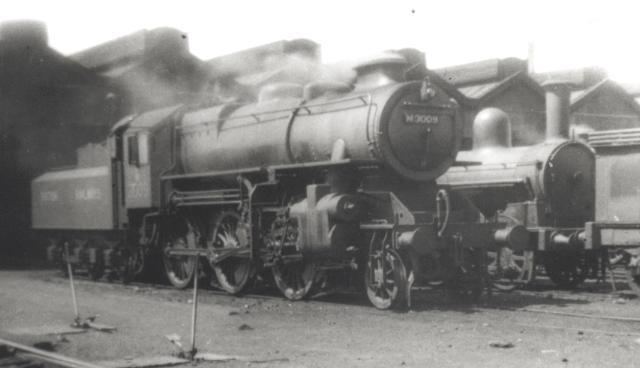Power type Steam Build date 1947-1952 | Designer H.G. Ivatt Total produced 162 | |
 | ||
Builder | ||
The LMS Ivatt Class 4 2-6-0 is a class of steam locomotive primarily designed for medium freight work but also widely used on secondary passenger services. The London Midland and Scottish Railway (LMS) built 162 of this type between 1947 and 1952, but only three were built by the LMS before nationalisation in 1948. Designed by H.G. Ivatt, they were classified 4F by the LMS and 4MT by BR. In BR days they were used extensively across the system, being prevalent on the London Midland region and to a lesser extent elsewhere, notably on the Midland and Great Northern Joint Railway, an East Anglian line that had previously been joint owned by the LMS and LNER, where they became the dominant locomotive type. They were also used for a short period on the Somerset and Dorset Joint Railway, but were quickly transferred elsewhere, never to return, because of poor steaming on the line's long and steep gradients – this was before modifications were made to the design which improved steaming notably.
Contents
Numbering
The first three engines were numbered 3000–3002 by the LMS, but became 43000–43002 when renumbered by BR – 40000 was added to the running number to indicate an ex-LMS locomotive. The remaining 159, built by BR, continued the number sequence: 43003–43161. Construction was divided between different locations, 75 were completed at Horwich Works, 50 at Doncaster Works and 37 at Darlington Works. The class was also sometimes called mucky ducks or doodle-bugs or even Flying Pigs.
Design
The design was noted for its American looks – the running-plates were positioned at a high level and a gap left ahead of the cylinders. Because of this many locomotive enthusiasts considered it to be the ugliest British locomotive produced, especially those locomotives outshopped with double chimneys (the first 50 engines); however, these gave poor performance and were quickly replaced with single chimneys. The locomotives also incorporated new mechanical features intended to reduce maintenance costs. The utilitarian appearance was a deliberate design decision as there are sketches which show the locomotive with conventional curved running plates.
The BR Standard Class 4 2-6-0 was based on this design. Its looks were improved somewhat by the re-design of the outside foot-plating, to include a sloping plate to fill the gap ahead of the cylinders.
Accidents and incidents
Withdrawal
The class were withdrawn between 1963 and 1968.
Preservation
Only one example survived into preservation, No 43106, the final member of the class in service, which was based at Lostock Hall depot, near Preston. Its last operational turn was just before Easter in 1968, but its last turn was interrupted by a derailment in Colne Goods Yard. Since 43106 had already been selected as the best of the remaining small group, a 'search party' was despatched on Easter Tuesday to survey the damage. It was felt that damage was so minimal the prospective owners would investigate the ease of a repair. On its return to Lostock Hall, the locomotive was repaired by fitters from Carnforth, that repair exists to this day. However it derailed again at Lostock Hall when being prepared for a test run in late July. It was steamed for the final time by British Railways on 1 August 1968 and departed at about 15:30 with one member of its new owning consortium on board. This was only after lengthy discussions to get the locomotive moved in live steam before 4 August, the end of steam operation on BR. The journey was carefully routed to limit movement 'under the wires', via Frodsham, Chester and Shrewsbury. The journey through the West Midlands continued via Wolverhampton High Level towards Bescot and Pleck Junction, where after a movement around a triangular junction to ensure it arrived the 'right way round' the light engine continued on to Stourbridge Junction where it was stabled overnight in the exchange sidings, now part of the extensive car park. On 2 August it continued on to its new life in preservation on the Severn Valley Railway appearing on the front page of the Shropshire Journal with three of its new owners giving it a much needed clean. It is affectionately known as the Flying Pig, although many railwaymen referred to the Ivatt 4s as Doodlebugs.
A major overhaul of the locomotive was completed in 2009 and it is currently operational after having damage repaired that it received during a derailment at Hampton Loade soon after returning to service. It received further repairs to the boiler in 2013.
Models
A OO gauge model of 43106 is produced by Bachmann Branchline, who also produce many other models of the Class 4, as well as the LMS Ivatt Class 2 2-6-0 and LMS Ivatt Class 2 2-6-2T.
